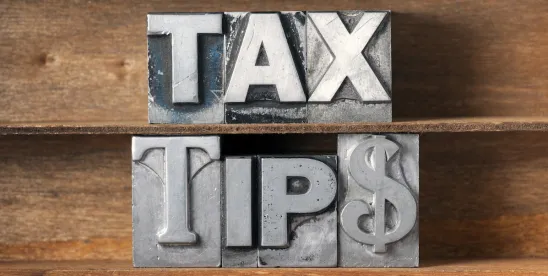One of President Donald Trump’s 2024 campaign messages was a promise to implement a no-tax-on-tips and no-tax-on-overtime law. On July 3, 2025, the U.S. Congress passed the “One Big Beautiful Bill,” and President Trump signed the bill into law on July 4. The White House offers a calculator for employees to determine their savings on tips and overtime and estimates how much eligible and affected employees in each state will save on average. The no-tax-on-tips and no-tax-on-overtime provisions are effective through December 31, 2028.
Quick Hits
- President Trump signed the “One Big Beautiful Bill” into law on July 4, 2025, which includes provisions for no taxes on tips and overtime effective through December 31, 2028.
- Employees who customarily and regularly receive tips can deduct up to $25,000 in tips from their income subject to federal income tax starting January 1, 2025, while businesses must report these tips on Form W-2 for employees and on Form 1099 for nonemployees.
- The act also allows workers to deduct up to $12,500 in overtime pay from their income subject to federal income tax, with businesses required to report qualified overtime compensation on Form W-2 for employees and on Form 1099 for nonemployees.
No Tax on Tips
Before the act, the Internal Revenue Service (IRS) defined all cash and non-cash tips received by an employee as income and subject to federal income taxes. All tips received by an employee in any calendar month were subject to Social Security and Medicare taxes and must be reported to the employer. Consistent with the IRS and federal wage and hour laws, the act defines “qualified tips” as amounts voluntarily paid by patrons and includes any tips obtained through a tip share.
Effective the tax year starting January 1, 2025, employees who “customarily and regularly receive tips on or before December 31, 2024, as provided by the Secretary” (the act mandates the secretary of the treasury (or the secretary’s delegate) to publish a list of occupations which “customarily and regularly received tips on or before December 31, 2024”) will be able to deduct up to $25,000 in tips from their income subject to federal income tax. This amount is reduced by $100 for each $1,000 by which the taxpayer’s modified adjusted gross income exceeds $150,000 ($300,000 in the case of a joint return). This income tax deduction is available to nonitemizers, which means that it can be claimed in addition to the standard deduction for individual income tax filers. This deduction has no effect on Social Security and Medicare taxes.
What employers need to know
Employers will need to report the total amount of cash and non-cash tips reported by an employee and the occupation of the employee on the employee’s Form W-2. Likewise, businesses and other payors that issue Forms 1099 to tipped contractors will have to separately report designated tips and the recipient’s occupation on the Form 1099. The act instructs the IRS to update the applicable income tax withholding procedures and tax forms to reflect this new deduction and required occupation listing.
The IRS has not yet provided guidance in light of the new law.
Some employers with tipped employees take advantage of the tip credit and are eligible to claim the Federal Insurance Contributions Act (FICA) tip credit. The credit permits employers to reduce taxable business income by the amount employers pay for the employer share of the Social Security and Medicare taxes (FICA tax) on certain employee tips. The employer share of the FICA tax is currently 7.65 percent. The act amends the Internal Revenue Code (IRC), which defines certain tips as eligible for the employer FICA tip credit. Currently, Section 45B(b)(2) of the IRC states that, for the purpose of calculating the employer FICA tip credit, only tips received by employees in connection with providing, delivering, or serving food or beverages for consumption are taken into account if tipping is customary in that establishment. The act expands Section 45B to include beauty service businesses (barbering, hair care, nail care, esthetics, and spa treatments) where tipping is customary. The act does not otherwise affect employers’ ability to take advantage of the FICA tip credit.
No Tax on Overtime
Section 70202 of the act also creates a tax deduction for “qualified overtime compensation.” Qualified overtime compensation is defined as “overtime compensation paid to an individual required under section 7 of the Fair Labor Standards Act of 1938 [FLSA] that is in excess of the regular rate.” Workers can deduct $12,500 ($25,000 in the case of a joint return) in overtime pay from their income subject to federal income tax. The deduction does not apply to overtime premiums required under state laws or collective bargaining agreements. This deduction also has no effect on Social Security and Medicare taxes.
What employers need to know
Similar to the tip deduction, this deduction is also available in addition to the standard deduction. Employers will need to report the total amount of qualified overtime compensation on their employees’ Forms W-2. Businesses will need to report the amount of qualified overtime compensation for nonemployees on their applicable Forms 1099, notwithstanding the fact that under the act qualified overtime compensation means “overtime compensation paid to an individual required under section 7 of the FLSA that is in excess of the regular rate at which such individual is employed.” The act requires the IRS to update the applicable income tax withholding procedures and tax forms to reflect this new deduction. Of note, the act also provides that businesses may approximate an amount designated as qualified overtime compensation by any reasonable method specified by the secretary of the treasury (which has yet to be issued as of today) for the 2025 tax year.
The IRS has not yet provided guidance in light of the new law.





 />i
/>i

